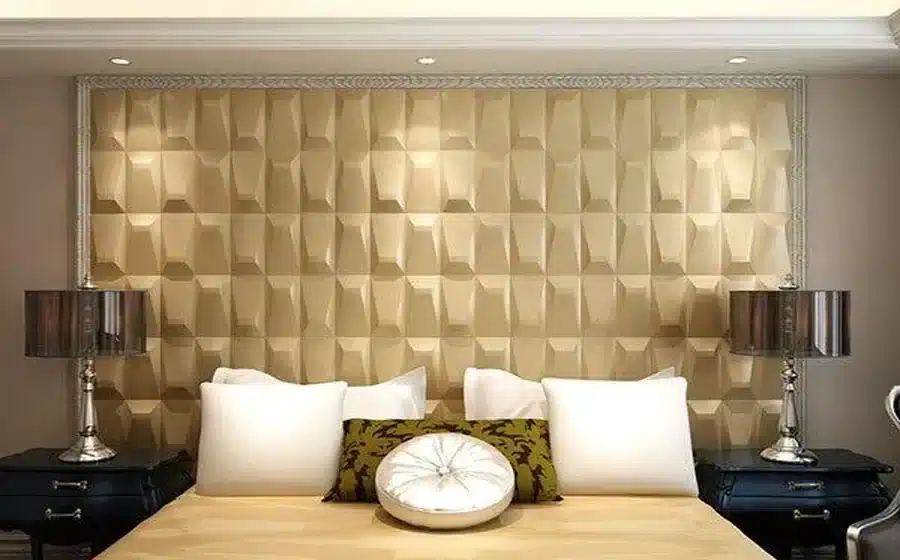The 3D wall panel is a revolutionary concept in the interior design industry, which is constantly changing, and 3D panels have the ability to provide not only beauty but also functionality to residential or commercial areas. These panels are changing the perception and use of walls by adding depth, texture and a modern appearance that creates a focus in any room. The emergence of 3D wall panels has been a response to the increasing desire to have a modern and dynamic design solution merging style with practicality.
Through this article, we shall examine the reasons behind the popularity of 3D wall panels, the different types of 3D wall panels, the benefits of using them and how you can use them in your design projects as a bold and stylish idea.
What Are 3D Wall Panels?
Wall panels Sometimes known as textured wall panels, 3D wall panels are flat wall panels made to look three dimensional. They are constructed using an assortment of materials such as PVC, gypsum, wood, metal and composite materials and are mounted on the walls in a manner that provides both a sense of depth as well as visual interest Unique walls. The panels are created to receive the light and shadow in distinct peculiarities, it is important to underline the texture and the shape of the surface.
The 3D wall panels are fitted on the walls to provide depth, motion, and personality to the walls that appear plain or dull. They can also be fitted in many different ways, letting the designer tailor the appearance to any style, be it modern, rustic, industrial, or minimalist..
The Evolution of 3D Wall Panels
The idea of textured wall panels is not new, but the development of 3D wall panels is a great step towards design development. In recent years, the desire to design a more visual and touchable environment has resulted in an extensive assortment of 3D panel designs that integrate creativity, sustainability and aesthetics.
The emergence of the 3D wall panel can be dated to the increasing interest in other styles of wall treatments that surpass the constraints of paint and wallpaper. Due to the development of materials and technology, manufacturers can now create high-quality lightweight panels that are not only aesthetically pleasing to the eye, but also simple to install and maintain.
Types of 3D Wall Panels
3D wall panels are available in various materials and designs, allowing homeowners and designers to select the right option for their specific needs. Here are some of the most popular types of 3D wall panels:
PVC 3D Wall Panels
Polyvinyl chloride (PVC) panels are considered to be one of the most popular types of 3D wall panel because of their versatility, low cost, and resilience. PVC panels are not heavy, clean easily and can be shaped into any shape and texture. They come in a variety of designs, both geometric and organic, and are installed both at home and in business.
They are moisture-resistant and fire-retardant, which is why these panels are a good option in the kitchen, bathroom, and other spaces with high humidity. PVC 3D wall panels are also environment-friendly and some of them are recycled materials and hence green design projects can use these materials.
Gypsum 3D Wall Panels
Gypsum panels are a popular choice for those seeking a more sophisticated and elegant look. Gypsum is a natural material that is widely used in construction and interior design due to its durability, ease of installation, and versatility. Gypsum 3D wall panels are often used to create modern, sleek surfaces with clean lines and subtle textures.
These panels can be painted in any color and are typically used in living rooms, hallways, and commercial spaces. They are also ideal for creating customizable designs, as they can be easily cut and shaped to suit different layouts.
Wood 3D Wall Panels
For those looking to add warmth and texture to their spaces, wooden 3D wall panels offer an organic, natural aesthetic. Wood panels can be crafted from a variety of timber types, including oak, maple, teak, and bamboo, and are often treated with stains or finishes to enhance their visual appeal.
Wooden 3D panels can be used in both modern and traditional settings, adding a rustic or industrial vibe depending on the design. They are particularly popular in living rooms, bedrooms, and offices. Additionally, wooden panels can have sound-absorbing properties, which is a significant benefit for spaces that require improved acoustics, such as home theaters or recording studios.
Metal 3D Wall Panels
For a more industrial or futuristic look, metal 3D wall panels provide a striking visual effect. These panels can be made from materials like aluminum, stainless steel, or copper, and often feature intricate patterns or textures that play with light and shadow. Metal panels are typically used in modern or urban spaces to add edginess, depth, and a sleek, high-tech appearance.
Metal 3D panels are durable, easy to maintain, and resistant to wear and tear, making them ideal for both residential and commercial applications. They are often used in lobbies, conference rooms, or as accent walls in living areas.
Fabric and Composite 3D Wall Panels
Some 3D wall panels are made from fabric or composite materials that combine natural fibers with resins. These panels are softer and more flexible than other types and can add a unique texture to a space. Fabric 3D wall panels are often used to create luxurious, soft finishes in bedrooms, lounges, or entertainment rooms.
Composite 3D panels are usually made from a combination of natural fibers, such as jute or hemp, and recycled resins. These eco-friendly materials are ideal for creating sustainable wall designs that blend modern aesthetics with environmental responsibility.
Benefits of 3D Wall Panels
The popularity of 3D wall panels can be attributed to their versatility and the numerous benefits they bring to interior spaces. Some of the primary advantages include:
Enhanced Aesthetic Appeal
The most obvious benefit of 3D wall panels is their ability to instantly transform the aesthetic of any room. With their intricate textures and patterns, these panels create a dynamic visual experience that adds depth and dimension to the walls. Whether you’re looking to create a bold statement or add subtle elegance, 3D panels offer endless design possibilities.
Improved Acoustic Properties
Many 3D wall panels, particularly those made from wood or fabric, have sound-absorbing properties that can significantly improve the acoustics of a room. These panels can help reduce echo, absorb noise, and create a more comfortable and quieter environment. This makes them an ideal choice for spaces like home theaters, music studios, conference rooms, or open-plan offices.
Easy Installation
3D wall panels are designed to be lightweight and easy to install, making them a convenient option for both DIY enthusiasts and professional installers. Most panels come with interlocking mechanisms, adhesive backing, or mounting clips, making them quick and hassle-free to apply. This ease of installation is a key reason why they have gained popularity in both residential and commercial settings.
Low Maintenance
Unlike wallpaper or painted walls, which may require frequent touch-ups or maintenance, 3D wall panels are highly durable and easy to clean. Most materials, such as PVC or metal, are resistant to stains, moisture, and wear, making them a low-maintenance option. Simply wipe them down with a damp cloth to keep them looking fresh and vibrant.
Sustainability
As sustainability becomes a more significant concern for homeowners and designers, 3D wall panels made from recycled materials or eco-friendly substances are becoming increasingly popular. Materials like recycled PVC, wood, and composite resins contribute to green building practices, reducing the environmental impact of construction and design projects.
Incorporating 3D Wall Panels Into Your Space
There are endless ways to incorporate 3D wall panels into your design project. Here are a few ideas to get you started:
- Living Room: Use 3D panels as a statement accent wall to create a dramatic focal point behind the sofa or entertainment unit.
- Bedroom: Add a touch of luxury by using textured wall panels behind the bed as a feature wall, creating a serene and calming atmosphere.
- Office: Incorporate sound-absorbing panels into conference rooms or open-plan offices to improve acoustics while maintaining a stylish, modern aesthetic.
- Kitchen: Create a backsplash or accent wall with metal or PVC 3D panels for a sleek, high-tech look.
Conclusion
The emergence of 3D wall panels is another evidence of the growing need to join form and functionality in the new design solution. The 3D panels are a versatile and convenient solution to enhance your space, with or without the use of textures, better acoustics, or an eye-catching visual effect. These panels are changing the way we imagine wall decor and pushing the limits of interior design with a variety of materials, designs, and finishes.



